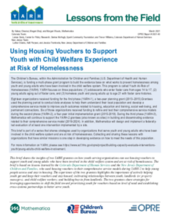Displaying 131 - 140 of 2168
This study uses a retrospective pre/post design to measure the impact of the pandemic on foster carers’ self-care.
This article seeks to echo the voices of 36 children aged 10 to 12 who participated in a therapeutic primary to secondary transition initiative for looked after children.
This article seeks to echo the voices of 36 children aged 10 to 12 who participated in a therapeutic primary to secondary transition initiative for looked after children. Informed by a participatory action research approach, its focus was to facilitate the child’s voice.
The current study used a resilience framework to describe youth experiences with their caseworkers, examine the association of youth–caseworker relationship quality with school engagement, and to examine the differential impact of youth–caseworker relationships on youth school engagement by level of youth risk (i.e. posttraumatic symptoms).
This research focuses on Somalis living in a large English city where there is a significant shortage of Somali foster carers and adopters despite people of Somali heritage comprising a sizeable proportion of the care and city population.
The present study seeks to examine the goals that carers who are looking after children with emotional and/or behavioural difficulties set at the start of an intervention, the Reflective Fostering Programme, designed to support them.
This paper reports on a small-scale, qualitative evaluation of an approach to working with children in care launched in Brighton and Hove called Me and My World. Core principles of the model are explained including continuity of relationship between social workers and children in care; a statutory review process which promotes participation of the child and young person and a recording system where social workers, IRO’s and foster carers write reports for review directly to the child.
This article exploresthe extent to which general strain theory (GST) and self-control theory can explain the mental health outcomes of youth in-care.
This article explores population-level prevalence of Posttraumatic stress disorder for Young Children (PTSD-YC) to test whether application of Alternative Algorithm for PTSD (AA-PTSD) criteria, relative to the DSM-IV PTSD algorithm, increases identification of 5-6 year old children with clinical needs, in both the general population, and among looked-after-children where the risk of mental health issues is greater.
This brief is part of a series that shares strategies used by organizations that serve youth and young adults who have been involved in the child welfare system and are at risk of homelessness. It examines a multi-phase grant program to build the evidence base on what works to prevent homelessness among youth and young adults who have been involved in the child welfare system in the U.S.

